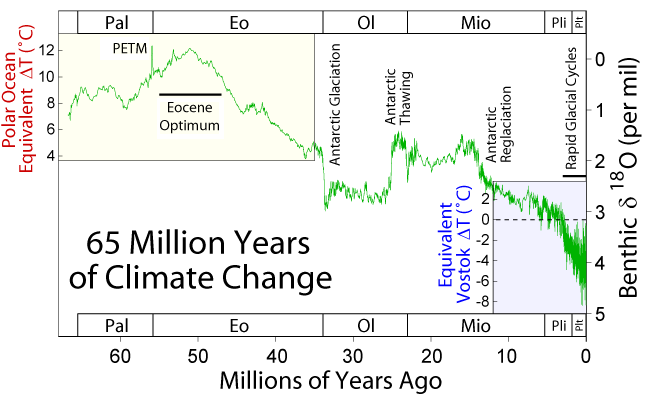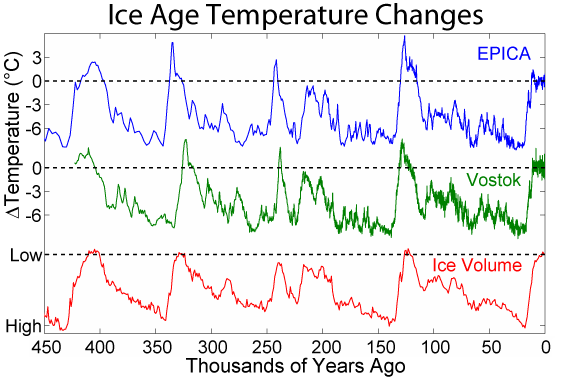From good 'ol Wikipedia:

And for good measure:

Someone on FR once posted that "normal is Chicago under a mile of ice." That's certainly been true recently. For example, for the last 500,000 years:

Posted on 09/20/2012 5:02:02 AM PDT by Renfield
(Phys.org)—When a huge meteor collided with Earth about 2.5 million years ago in the southern Pacific Ocean it not only likely generated a massive tsunami but also may have plunged the world into the Ice Ages, a new study suggests.
A team of Australian researchers says that because the Eltanin meteor – which was up to two kilometres across - crashed into deep water, most scientists have not adequately considered either its potential for immediate catastrophic impacts on coastlines around the Pacific rim or its capacity to destabilise the entire planet's climate system.
"This is the only known deep-ocean impact event on the planet and it's largely been forgotten because there's no obvious giant crater to investigate, as there would have been if it had hit a landmass," says Professor James Goff, lead author of a forthcoming paper in the Journal of Quaternary Science. Goff is co-director of UNSW's Australia-Pacific Tsunami Research Centre and Natural Hazards Research Laboratory....
(Excerpt) Read more at phys.org ...
From good 'ol Wikipedia:

And for good measure:

Someone on FR once posted that "normal is Chicago under a mile of ice." That's certainly been true recently. For example, for the last 500,000 years:

http://en.wikipedia.org/wiki/Ice_age
Most interestingly, the Wikipedia article on Ice Ages also has a new piece of information that seems to parallel a hunch I've had for a long time: "According to research published in Nature Geoscience, human emissions of carbon dioxide will defer the next ice age. Researchers used data on the Earth's orbit to find the historical warm interglacial period that looks most like the current one and from this have predicted that the next ice age would usually begin within 1,500 years. They go on to say that emissions have been so high that it will not."
Recall that the last Ice Age glacial period nearly terminated mankind, and it's unlikely that (from a % surviving standpoint) we would do much better next time. A few extra degrees, IF they happen, is a much more survivable scenario. Also note from the graphs above that our current interglacial temperatures have not exceeded those of the last, nor are temperatures in the present period close to those in periods when life on earth was at it most prolific.
Yes - see my last post.
I used to think that, but the more I learn about boloids, megavolcanoes and the like I can also see other important factors. For example the Long Valley (CA) mega crater just over 700,000 years ago, the Yellowstone megaeruption around 640,000 years ago. Something triggered our most recent major ice age about 125,000 years ago, but the megavolcano Toba sent the temperature even more sharply downward about 74,000 years ago. I haven’t studied time lines on boloid events in the past million years, but bet there would be some interesting possibilities there also.
Note the abrupt temp. drop at the Eocene Oligocene boundry 34 million years ago. Almost certainly caused by the Chesapeake Meteor with 60 mile diameter crater, the Popogai (sp?) meteor crater in Siberia, and the 10 mile diameter Toms River crater off NJ all of which fell about the same time.
nice charts...book marking them. What data is it, all ice core records?
Very nice posts and graphics. Thanks.
Ice core data (blue/red): ftp://ftp.ncdc.noaa.gov/pub/data/paleo/icecore/antarctica/vostok/deutnat.txt
Direct measurement (green): ftp://ftp.ncdc.noaa.gov/pub/data/anomalies/annual.land_ocean.90S.90N.df_1901-2000mean.dat
Thanks. I sometimes wonder that ice core records are not like political polls in the sense that it may be a good way to see movement, but how can we be sure its calibrated for conditions in the past that may have been different than current conditions. In particular I am wondering how much regression analysis is done to make the transition from direct measurement vs less direct methods. How much interpretation and guess work goes into making a smooth transition between the types of measurement? How do we make sure that a sloppy analysis like the infamous Mann hockey stick isn’t contrived in whatever data we view...whether it is favorable to our own point of view or not? Alas, I am wondering, but don’t have time or inclination enough to investigate...putting it on the back burner and getting back to work...
If the thing hit where this team thinks, between Chile and Antarctica, the tsunami would have hit both the Pacific and Atlantic.
Most of the water movement would be due to the evacuation of the crater — the water in the impact area would go straight up as very hot vapor, and the surrounding seas would flow in from all directions to fill in the hole.
Obviously, an event of this magnitude would have a huge effect on the planet. I’m just not a good enough scientist to figure out how this event would trigger the Quaternary and the pattern of glacial/interglacial periods we’ve had since.
A volcano is a pimple on the ass compared with a bolide impact. And glaciation results from heat, not cold, which is why massive cloud cover won’t cover the Earth with miles of ice — the hydrologic cycle slows to the level seen well, on Antarctica, dryest of the continents (but not due to cloud cover). Energy is needed to evaporate all that water, and is delivered from above, by a big fast-moving chunk of space debris; the water vapor rises with the fireball; the heat in the vapor is shed at high altitude; the precipitation falls as ice, snow, sleet, freezing rain, and some rain.
Antartica had temperate flora 3 million years ago. The Eltanin impact happened 2.5 million years ago. The myth of the 30 million year old Antarctic ice cap is going to die hard — but it will die.
It wouldn’t — it triggered one glaciation, and each glaciation was triggered by a different impact. Impacts don’t happen cyclically or on a schedule, they just happen when they happen. :’) And it’s stuff like that which cause people to call me Mister Sunshine.
Gotcha. I agree impacts don’t arrive on schedule, so something else must be driving the pattern the planet is in right now.
There’s a climate cycle, of a sort, and it is evidenced by the periodic egress of invasive groups going east and west on the steppes, into Europe, the Near East, and China. It isn’t related to the Milankovich model, which is largely a cartload. The point I was making about the non-periodic nature of large impacts is, the impactors may be chunks broken off a much larger object. That object may have just been passing through, or on the short leg of its long, long path around the Sun, or perhaps it broke apart due to stresses of passing by the Sun, and became a train of smaller objects. Since their orbits probably are very similar to the parent body, they’d arrive from time to time in small groups.
The Eltanin Impact Crater
Geological Society of America | October 27-30, 2002 | Christy A. Glatz, Dallas H. Abbott, and Alice A. Nunes
Posted on 10/17/2004 9:46:13 PM PDT by SunkenCiv
http://www.freerepublic.com/focus/bloggers/1248414/posts
Disclaimer: Opinions posted on Free Republic are those of the individual posters and do not necessarily represent the opinion of Free Republic or its management. All materials posted herein are protected by copyright law and the exemption for fair use of copyrighted works.